Over the past decade, mountain bike geometry has undergone significant changes, nowhere more so than in the enduro bike category.
The geometry of the bikes raced at the first Enduro World Series (EWS) event in 2013 weren’t in the same league as even today’s aggressive cross-country bikes – then, a 67-degree head angle was considered slack, and a 425mm reach on a medium frame was relatively standard. In addition, many of those early enduro bikes still had front derailleurs and 26in wheels.
Today’s enduro bikes feature vastly different geometry, but this transformation didn’t happen overnight. Instead, incremental refinements have been made each production cycle, which contributed to a general trend towards building longer, lower and slacker bikes that are able to charge down the timed stages yet still be pedalled uphill on the transitions.
Most brands played this game, with some being more eager to try new things, and others following behind with a more reserved approach.
However, over the past few seasons, things seem to have settled down, with the majority of brands now settling on broadly similar figures for their enduro bikes. A 64-degree head angle, plus or minus half a degree, is expected. Reach figures around the 455mm to 470mm range for a medium frame are now also common.
The question is, have these modern enduro bikes landed on the geometry sweet spot, or do the handful of even longer and slacker rigs available highlight that there’s still room for improvement?
To find out, we've pitched two bikes head-to-head to determine where each has strengths and weaknesses, and how their geometry translates into ride quality out on the trail.
Meet the mules
I tested two top-spec enduro rigs for this head-to-head comparison – the Orbea Rallon M-LTD and the GeoMetron G1. Both have been built for speed, but there are significant differences in how the brands have gone about achieving that.
Orbea Rallon M-LTD

The Orbea Rallon is a full-carbon race machine, built to tackle the EWS and designed with the philosophy of ‘focus on fast’. It delivers 160mm of rear-wheel travel and is light for its type at 14.59kg. The frame features built-in storage plus internal cable routing and bolt-on chainstay protection.
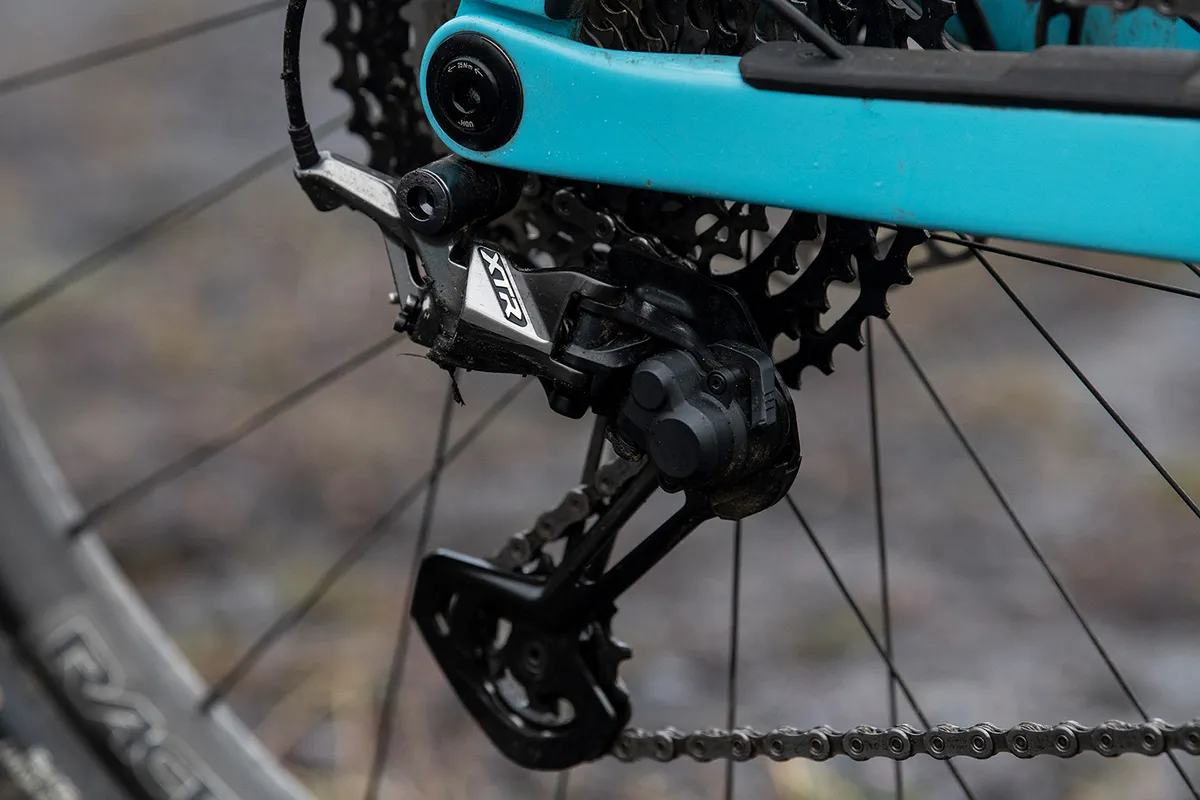
It’s dripping with carbon kit, in the form of Race Face Next R wheels, cranks and handlebar. Gears and brakes are top-of-the-range Shimano XTR M9100, while a Factory-level Fox 38 fork, Float X2 air shock and Transfer dropper post deck the bike out in Kashima gold.
Orbea’s engineers settled on the geometry by working with their enduro race team and analysing current EWS course profiles to build a bike that, it claims, would excel on them. The frame comes in four sizes and can be switched between ‘low’ and ‘lower’ settings using a flip-chip in the shock yoke.
I tested the bike in its ‘lower’ setting, which gives a 64-degree head angle and 77-degree effective seat tube angle. The reach on my medium frame was 460mm; this figure ranges from 435mm on the small to 510mm on the extra-large.
Each size shares the same 440mm chainstays. The wheelbase is 1,231mm, and it’s a low-slung bike with a 35mm bottom bracket drop.
Orbea Rallon M-LTD specifications
- Weight: 14.59kg (32.2lb), medium size without pedals
- Frame: Carbon fibre, 160mm travel
- Fork: Fox 38 Factory, 170mm travel
- Shock: Fox Float X2 Factory
- Drivetrain: Shimano XTR M9100 w/ Race Face Next R cranks (1x12)
- Wheelset: Race Face Next R
- Tyres: Maxxis Assegai 3C MaxxTerra EXO 29x2.5in WT (f) and Maxxis Minion DHR II 3C MaxxTerra EXO 29x2.4in WT (r)
- Brakes: Shimano XTR M9120, 203/180mm rotors
- Bar: Race Face Next R 35, 800mm
- Stem: Race Face Turbine 35, 40mm
- Seatpost: Fox Transfer Factory
- Saddle: fi’zi:k Tiaga Klum
- Price: £9,499
Details
- Stealth storage: Orbea’s Lockr system lets you stash a tool bag inside the down tube so you can carry spares on the bike, not your back. Also tucked away are two small multi-tools, in the rear axle and main pivot.
- Wheel compatibility: Just like the G1, the Rallon can take either a 29in or 650b rear wheel. Orbea supplies a second shock yoke for use with the smaller wheel size, which forgoes the flip-chip adjustability of the 29in version. Instead, you get geometry that’s the same as the 29er bike in its lower setting.
- Straight seat tube: The Rallon’s seat tube is uninterrupted by kinks or pivots, so it’s possible to run a 200mm-travel dropper post, even on the small size.
Orbea Rallon M-LTD geometry
| | S (h/l) | M (h/l) | L (h/l) | XL (h/l) |
|---|---|---|---|---|
| Seat angle (degrees) | 77.5/77 | 77.5/77 | 77.5/77 | 77.5/77 |
| Head angle (degrees) | 64.5/64 | 64.5/64 | 64.5/64 | 64.5/64 |
| Chainstay (mm) | 440 | 440 | 440 | 440 |
| Seat tube (mm) | 415 | 415 | 435 | 460 |
| Top tube - eff (mm) | 572 | 599 | 626 | 653 |
| Head tube (mm) | 90 | 100 | 110 | 120 |
| Bottom bracket drop (mm) | 28/35 | 28/35 | 28/35 | 28/35 |
| Bottom bracket height (mm) | 350/343 | 350/343 | 350/343 | 350/343 |
| Wheelbase (mm) | 1202 | 1231 | 1260 | 1290 |
| Standover (mm) | 737 | 737 | 754 | 774 |
| Stack (mm) | 619 | 628 | 637 | 646 |
| Reach (mm) | 435 | 460 | 485 | 510 |
GeoMetron G1 (Staff spec EXT ERA fork upgrade)
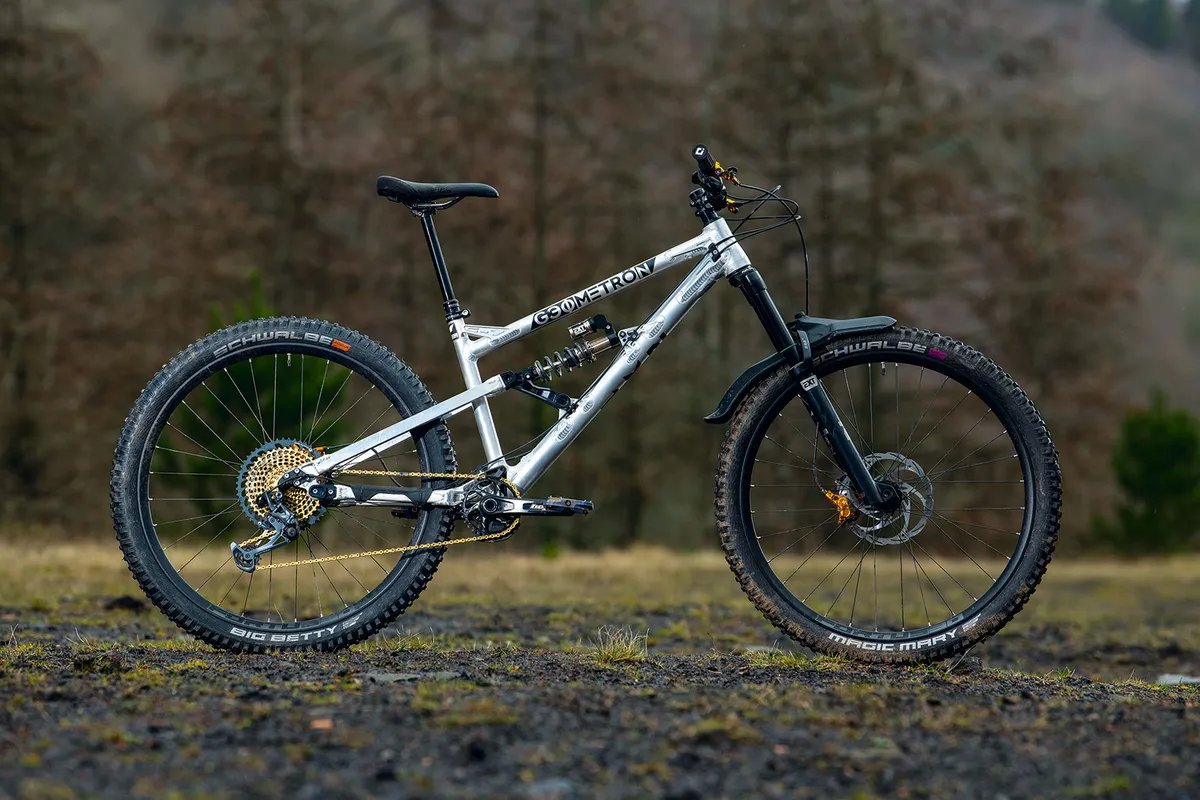
GeoMetron, meanwhile, has developed and refined the G1 to deliver a new enduro machine that the brand claims is unrivalled in traction, safety and speed.
It couldn’t be any more different from the Rallon, with its raw aluminium construction, industrial looks and external cable routing. With not a hint of carbon fibre, the G1 weighs a hefty 16.76kg.
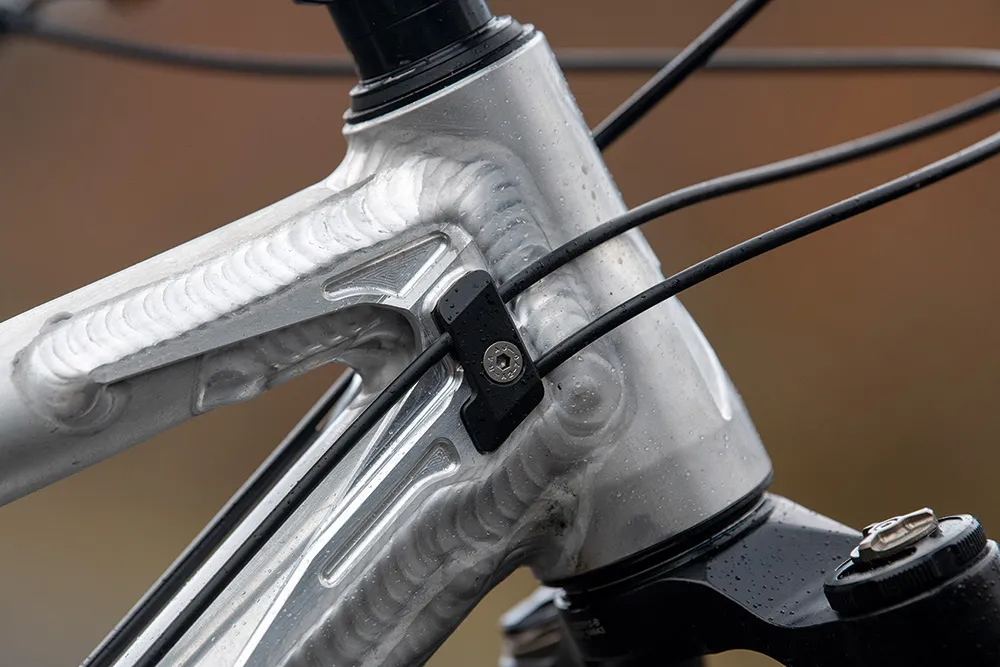
The frame offers two shock settings – I tested it in 175mm-travel mode, but there’s also a 162mm option. The build option tested here is the ‘Staff spec’, but with an upgrade to an EXT ERA fork, to match the frame’s EXT Storia V3 shock.
You get SRAM X01 Eagle gearing, Hope Fortus 30 wheels, Formula Cura 4 brakes and finishing kit from Hope, Renthal, WTB and BikeYoke.
Frame ‘Mutators’ allow plenty of geometry adjustment on the GeoMetron. I tested it in stock form – effectively the lowest and slackest configuration – with the chainstays in the shortest setting.
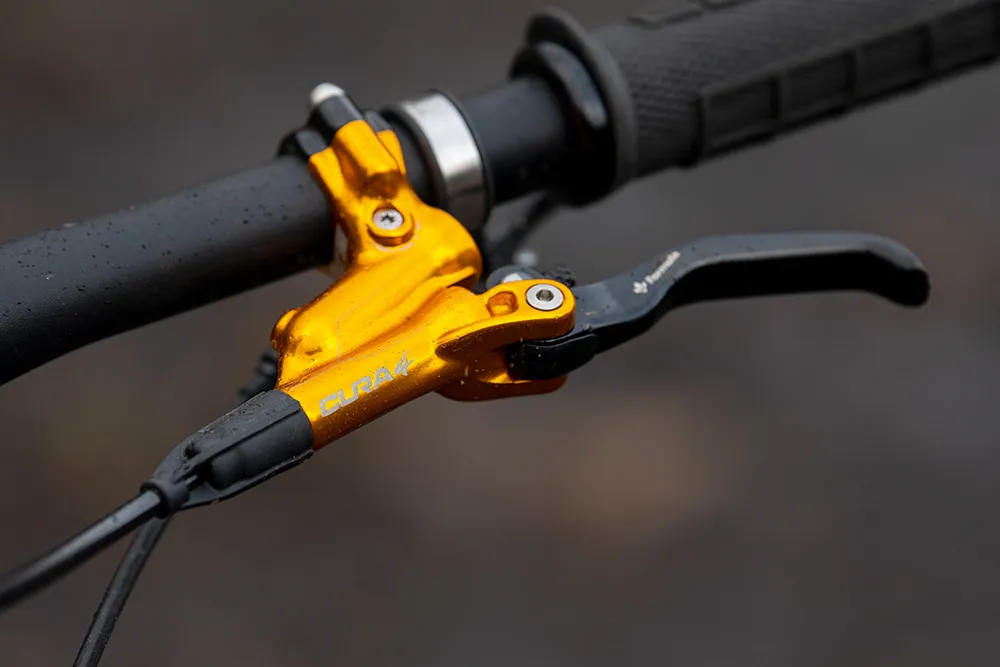
This gives a 62.5-degree head angle and 78.5-degree effective seat tube angle. I rode the ‘longer’ size, as that’s what GeoMetron advised, which has a 495mm reach, 446mm chainstays, 1,300mm wheelbase and 32mm bottom bracket drop. Reach spans from 465mm to 555mm across the five sizes.
GeoMetron G1 specifications
- Weight: 16.76kg (36.9lb), medium size without pedals
- Frame: 7020-T6 aluminium alloy, 175/162mm travel
- Fork: EXT ERA, 170mm travel
- Shock: EXT Storia V3, supplied with two coil springs
- Drivetrain: SRAM X01 Eagle w/ Hope EVO cranks (1x12)
- Wheelset: Hope Fortus 30 Pro 4
- Tyres: Schwalbe Magic Mary Super Gravity ADDIX Ultra Soft 29x2.4in (f) and Schwalbe Big Betty Super Trail ADDIX Soft 29x2.4in (r)
- Brakes: Formula Cura 4, 203/180mm rotors
- Bar: Renthal Fatbar 35, 800mm
- Stem: Hope AM 35, 35mm
- Seatpost: BikeYoke REVIVE
- Saddle: WTB Volt
- Price: £7,240
Details
- Frame adjustment: The G1 comes with ‘Mutators’ – swappable chainstay and seatstay extenders, available in a variety of lengths – that let you adjust its bottom bracket height, head and seat tube angles, and chainstay length. You can also set the bike up for use with 29in, 650b or mixed wheel sizes via a simple headset cup switch.
- External cable routing: Clever cable guides make maintaining and replacing brake and gear hoses a simple job.
- Spherical eyelet bearings: These let the shock rotate slightly on its mounts, which helps isolate it from rotational forces under compression, when the rear stays are flexing under high loads. The idea is to minimise friction and improve rear suspension sensitivity and performance.
GeoMetron G1 geometry
| | Long | Longer | Longest | XLongest | XXLongest |
|---|---|---|---|---|---|
| Seat angle (degrees) | 78 | 78.5 | 78.75 | 79 | 79 |
| Head angle (degrees) | 62.5 | 62.5 | 62.5 | 62.5 | 62.5 |
| Chainstay (mm) | 446 | 446 | 453 | 453 | 458 |
| Seat tube (mm) | 415 | 438 | 455 | 475 | 500 |
| Top tube - actual (mm) | 545 | 569 | 589 | 605 | 624 |
| Top tube - effective (mm) | 600 | 622 | 642 | 659 | 681 |
| Head tube (mm) | 110 | 120 | 130 | 140 | 150 |
| Fork offset (mm) | 42 | 42 | 42 | 42 | 42 |
| Wheelbase (mm) | 1271 | 1300 | 1324 | 1347 | 1371 |
| Standover (mm) | 728 | 728 | 728 | 748 | 770 |
| Stack (mm) | 615 | 624 | 633 | 642 | 649 |
| Reach (mm) | 470 | 495 | 515 | 535 | 555 |
Why would you want a long, slack and low bike?
What exactly makes a bike long, slack and low?
‘Longer’ relates to both wheelbase and reach, ‘lower’ to bottom bracket height and ‘slacker’ to head angle. Combined, they make for a bike that’s more stable at speed and more planted through the turns, but there are disadvantages, too.
This is because a longer wheelbase (the distance between the front and rear wheel axles) provides more stability.
Any change in rider position – due to hard braking, riding down a steep chute or over rough ground, for example – disrupts the weight balance between the wheels less, as that movement is a smaller percentage of the distance between them.
However, a longer wheelbase also makes it more challenging to load (apply force to) either wheel – to push the front wheel into a turn for grip or to unweight it to pop a manual, for example.
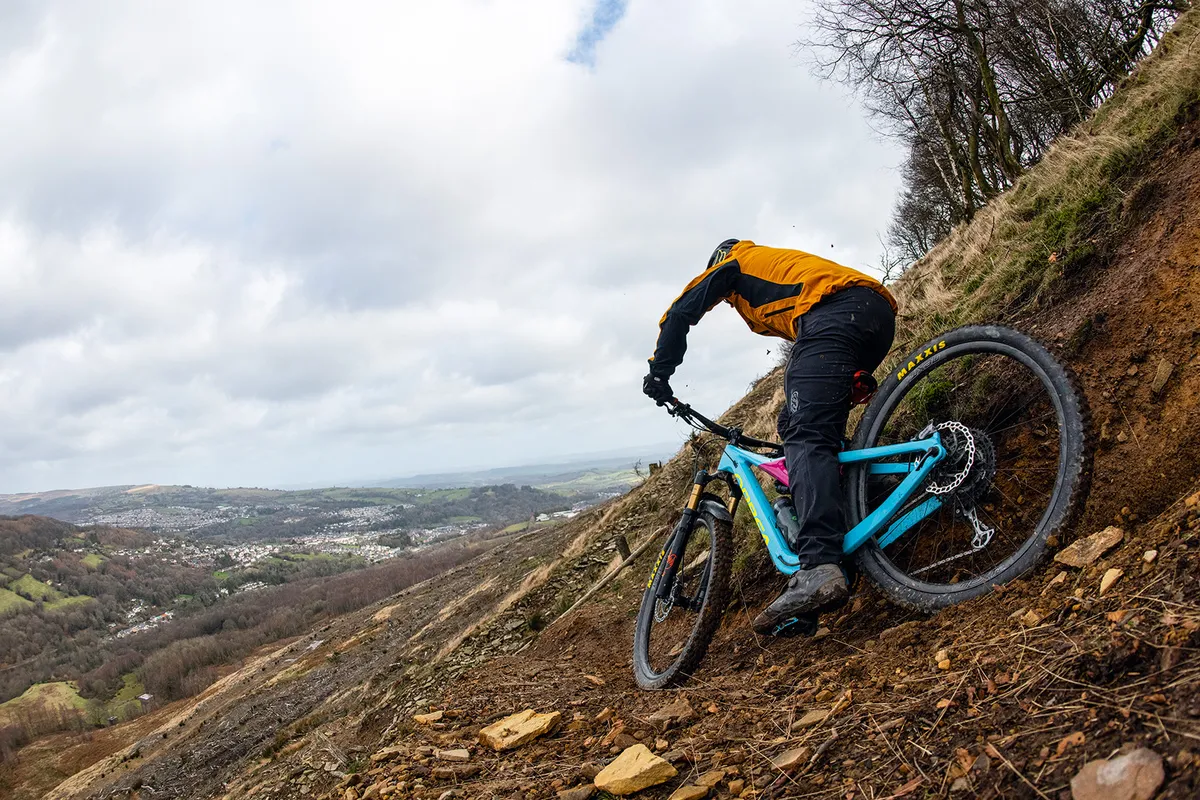
Also, at slower speeds, a bigger steering angle (how much you need to turn the bar) is needed to get a longer bike around a turn. This is particularly noticeable in switchbacks.
Reach (the horizontal distance between the centre of the bottom bracket and the centre of the top of the head tube) is important, too, as it determines how much space a rider has to move around the bike when standing up on the pedals.
A longer reach gives more room, but means the rider has to move further to affect weight change between the wheels.
If all other geometry figures remain the same, a slacker head angle lengthens the bike’s front centre (the horizontal distance between the bottom bracket and front axle).
This again increases stability, by stopping the bike from pitching forward under braking or when hitting bumps. It also increases the ‘trail’ figure, which makes the steering less twitchy, but also, when combined with the slacker fork angle, less responsive.
A lower bottom bracket has a similar effect to a longer wheelbase, reducing how much the bike pitches forwards and backwards under acceleration or deceleration, thus making it more stable.
It also lowers the centre of mass of the bike and rider closer to the tyres’ contact patch (which the bike rotates around when leaning over), making it easier to flick from side to side. If the bottom bracket is too low, you’ll find yourself forever bashing the pedals on the ground.
When looking at bottom bracket height on a full-suspension bike, you need to take sag into account; longer-travel machines require a higher (static) bottom bracket height as they have greater sag (in terms of millimetres and often a percentage, too).
For more information on all of these figures and how they affect bike handling, check out our full guide to bike geometry and handling.
GeoMetron G1 vs Orbea Rallon M-LTD geometry comparison
| | GeoMetron G1 | Orbea Rallon M-LTD |
|---|---|---|
| Longer (M) | M | |
| Seat angle (degrees) | 78.5 | 77 |
| Head angle (degrees) | 62.5 | 64 |
| Chainstay (mm) | 446 | 440 |
| Seat tube (mm) | 438 | 415 |
| Top tube (mm) | 622 | 599 |
| Head tube (mm) | 120 | 100 |
| Bottom bracket height (mm) | 333 | 343 |
| Wheelbase (mm) | 1300 | 1231 |
| Standover (mm) | 728 | 737 |
| Stack (mm) | 624 | 628 |
| Reach (mm) | 495 | 460 |
Traditional vs extreme mountain bike geometry – climbing performance
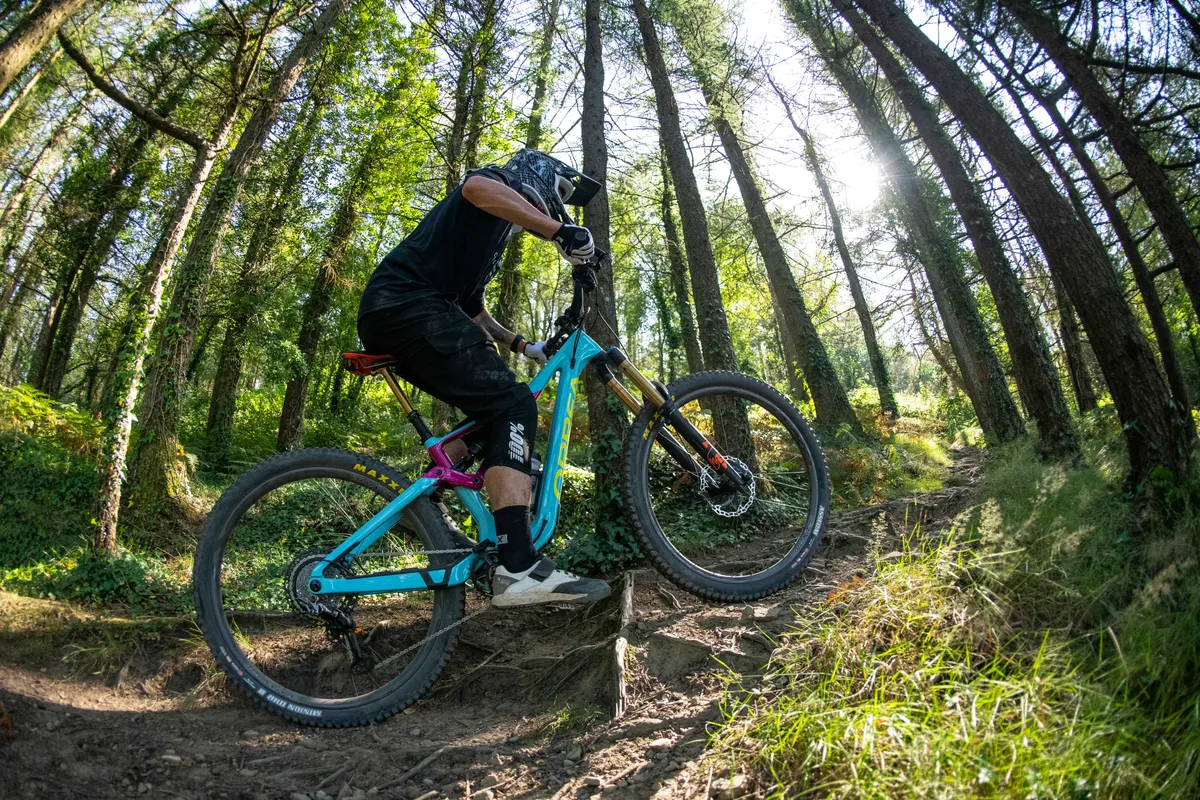
While these bikes have a gravity focus, they’re designed to let you climb to the top under your own steam in a relatively painless fashion – and with enough energy left to rip down the timed stages at full gas.
While there’s a 35mm reach difference between the two frames, the G1’s effective top tube length is just 23mm longer, because of its steeper seat tube angle (78.5 degrees compared with 77 degrees).
Add in the 5mm-shorter stem on the GeoMetron and the fact that I slammed its saddle forwards on its rails, and I could get the seat-to-grips distances of the two bikes to within a few millimetres of each other.
The seated position on both bikes is comfortable, thanks to their steep effective seat angles, which puts you in a good place over the bottom bracket to deliver an efficient pedal stroke.
Both bikes can winch up steep climbs without spinning out or wandering all over the trail, but the G1 has more laboured steering and takes more concentration to control at slow speeds up steep gradients.
Still, its longer chainstays and more forward-seated climbing position let you keep enough weight over the front, even though the wheel is slung further forward.
In terms of pedal bob, on both bikes I was happy to spend most of my climbing time with the shock in its open setting, only firming up the rear suspension on the steepest ascents.
This is thanks to decent levels of anti-squat – GeoMetron tells me the G1 has around 110 per cent anti-squat at sag, while, reading the chart for the Rallon, that figure is a little higher, at around 125 per cent.
The Orbea certainly feels like the sprightlier climber, though. It’s just over 2kg lighter and its Maxxis tyres have a midweight EXO casing and reasonably easy-rolling 3C MaxxTerra compound – perhaps a little trail-orientated for an enduro bike.
The GeoMetron has similar rear rubber, with Schwalbe’s Super Trail casing and ADDIX Soft compound, but a beefier, tackier Super Gravity ADDIX UltraSoft front tyre, which undoubtedly adds drag.
That said, both these bikes will get you to the top of most climbs comfortably and neither is a lousy climber for their suspension travel and category.
Traditional vs extreme mountain bike geometry – descending performance
Getting gravity on your side makes these speed machines a ton of fun to ride. With their wish-list build kits, I didn’t have issues with the performance of any of their components.
But this test isn’t to determine which has the best spec – it’s about frame design.
I'm very familiar with the Fox suspension on the Orbea, so it didn’t take long to feel at home using my regular settings. The Rallon has a progressive leverage curve, so I ran almost 35 per cent sag and removed all volume spacers from the shock.
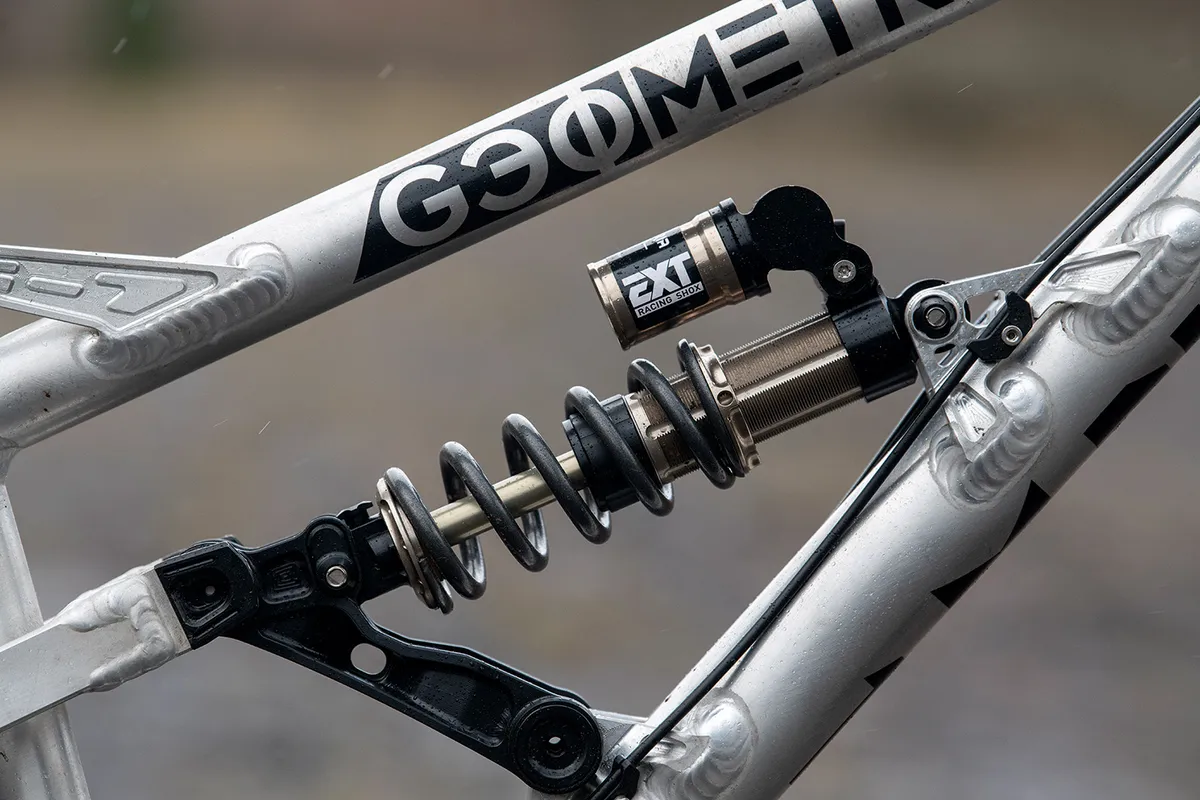
I am less familiar with the EXT ERA fork and Storia V3 shock. Still, when I collected the bike from GeoMetron, the brand's people helped me set it up, swapped springs and gave me all the info I needed.
I began testing on more mellow, flowy trails and instantly felt comfortable on the Rallon. Your body weight is nicely balanced between the wheels, it feels like many other bikes we’ve ridden and its handling is intuitive.
The bottom bracket is a couple of percentage points more neutrally located between the wheels than on the G1, which is a little more rear-biased because of its stretched front centre, even with its longer back end.
There’s a nippy and urgent feel to the Orbea’s handling on smooth-flow trails. This allows it to be very reactive, without it in any way feeling nervous, so you can play around, pumping into small berms and quickly popping the bike from side to side. It’s not a trail bike, but it has some agility.
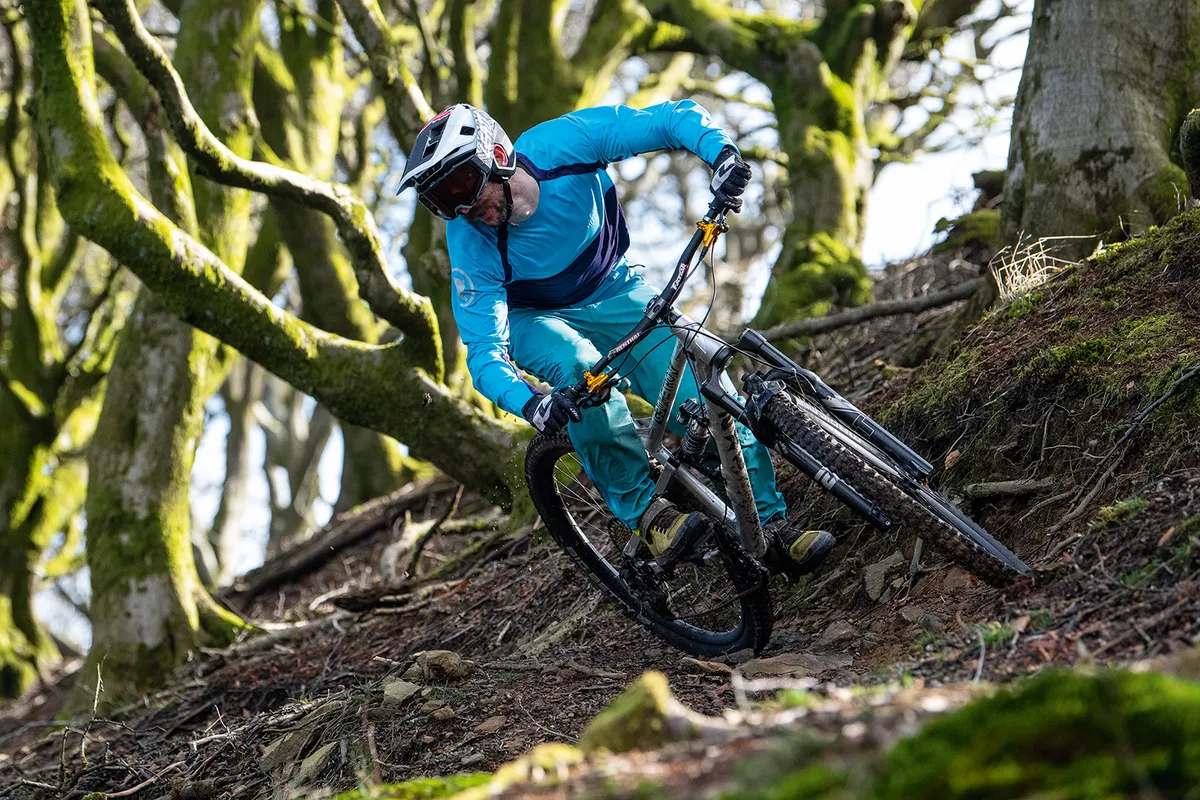
The longer wheelbase of the GeoMetron means it isn’t as entertaining to ride on these smoother tracks.
Rather, it provides excellent stability and calms the trail down. This may be ideal for those wanting maximum security, but riders looking for an engaging ride may feel underwhelmed.
That’s not to say the G1 can’t be playful, but it takes more effort to get it to feel alive on this type of trail.
Getting rowdier
Taking these bikes to terrain that properly challenged them highlighted a few more differences. Off-piste trails with a moderate gradient illustrated how the GeoMetron benefits from being ridden with more gusto.
With its front wheel 63mm further forward (from the bottom bracket) than the Orbea’s and a more rearward weight balance, I had to make a conscious effort to ride with my weight over the front of the bike. I also quickly learned that my usual range of movement wouldn’t cut it on the G1.
On my first runs, I found myself hampered by understeer in turns, unable to maintain my line. Adopting an aggressive, forward posture on the bike helped me get to grips with it.
To ride the GeoMetron with the commitment needed takes a fair amount of courage, because you have to shift forwards more than expected. It also gives you a good workout, as you have to support more of your weight with your arms.
However, when you get things right on the G1 it hooks up in the corners and provides a predictable platform to push from and let loose. Long flat turns are a definite highlight – here, the bike’s stability is rewarded with masses of grip and composure.
Throwing the Rallon into the off-piste, it demonstrates an eagerness to let you do what you want with it. I could ride it on autopilot and trust that it’d get the job done, and it didn’t take any additional thought or planning to ride at the edge of my comfort zone.
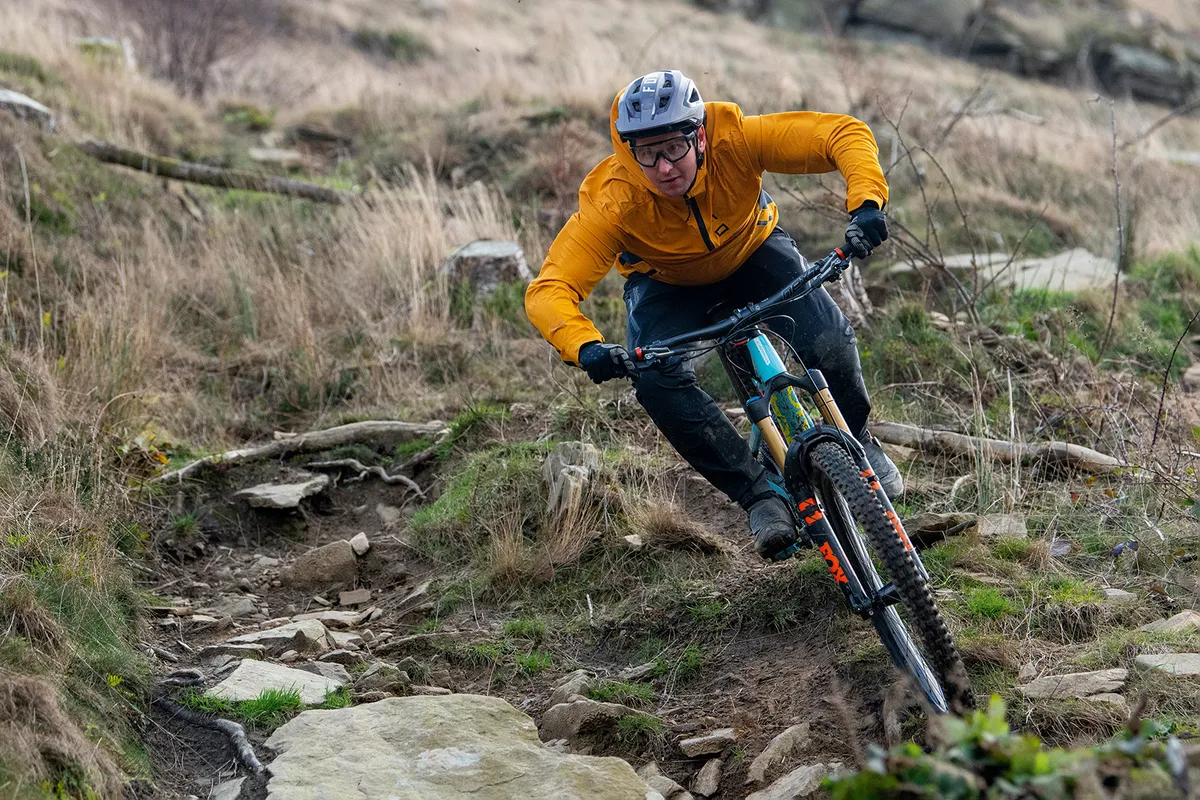
That gave me extra bandwidth for concentrating on other aspects of riding, such as braking and line choice.
I found I could use less body movement to manoeuvre the bike around turns, and was able to use my legs to support my weight and my arms to control the bike, making it less physical to ride.
The Orbea has a sharp accuracy that lets you adjust and make corrections on the fly without significant pauses in momentum.
On the G1, mid-turn line changes or fast adjustments to where you want to place your tyres on the trail are hindered by the bike’s slower reactions. I also noticed that the GeoMetron punishes mistakes more severely.
The Rallon could be wrestled to correct riding errors, whereas the G1 was less forgiving and I more often found myself stalling on the exit of turns.

There are though undoubtedly situations where the GeoMetron’s front wheel being further in front is a noticeable benefit. It shines when dropping down steep chutes onto flat fireroads or heading into 90-degree catch berms with a flat exit.
Tackling these features on the G1 gives you more confidence to hit them hard, because you don’t feel like the front wheel is going to tuck under. Still, to make it behave through these sections, you need to keep that commitment to the front of the bike.
It’s easy to end up a little too far back, which quickly removes weight from the front wheel, leaving you pushing the front end through corners, rather than just gripping and turning.
On the Rallon, I never encountered any trails that were steep enough to make the 64-degree head angle feel insufficient, although if you often ride super-steep drops into catch berms you may wish it were a little slacker.
It didn’t take such an ‘attacking’ position to keep the front wheel where I wanted it and not have to worry about it blowing out of turns.
Horses for courses
So, which of these two would I pick? Well, for the trails I tested, in the conditions I had, it’d be the Orbea.
Is that to say it’s the best bike? It’s not that simple.
First, it has more familiar geometry and, even though I rode these bikes back-to-back for several weeks, maybe I just didn’t have enough time to get used to the G1. Also, most of my testing was on slippery, technical off-piste trails.
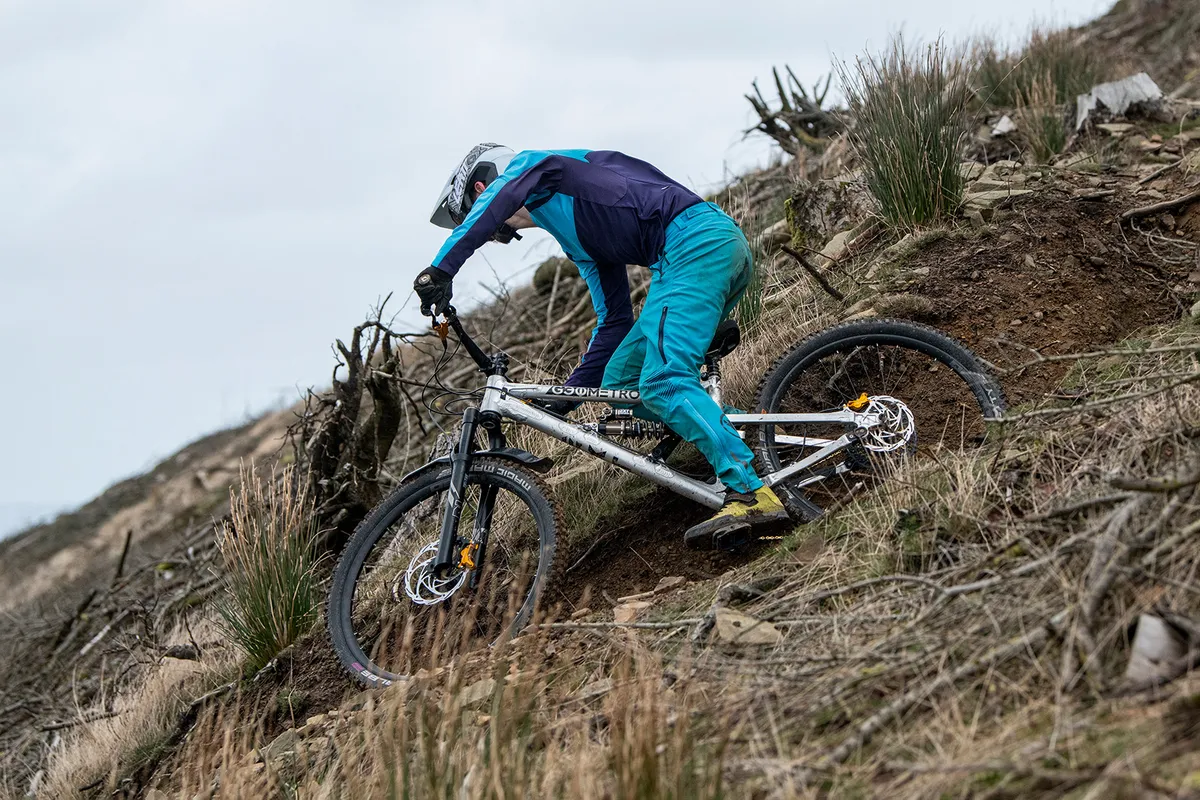
I put in some uplift days at BikePark Wales, too, but it still couldn’t offer speeds found on a dry high-speed mainline track such as Pleney in Morzine – a track I think would really suit the GeoMetron, which I feel has a higher ceiling for outright speed.
The G1 has plenty to offer, but it requires more rider muscle and suitable trails to realise its potential. I could more consistently ride the Rallon fast, even if I was closer to its upper limits. Of course, testing on different trails in drier conditions could have led me to a different conclusion.
One big bonus of the G1 is its sizing – and GeoMetron’s incredible customer service. For tall riders whose range of movement is bigger, it makes total sense, its longer frame allowing them to more easily transfer weight.
So, is there a geometry sweet spot? As the Rallon shows, contemporary geometry will do everything well. The G1, on the other hand, does some things to an exemplary level, but is compromised in other areas.
You need to weigh up what type of riding you do, how you want your bike to behave and how aggressive a rider you are. I reckon the GeoMetron will remain an outlier over the coming years, with its slacker-than-downhill-bike head angle and its medium size being longer than the extra-large Orbea.
The good news is that, with dropper posts getting longer (such as the 240mm OneUp) and seat tubes being made correspondingly shorter, many bike companies are giving riders the opportunity to pick between two, or even three, sizes to best suit their needs, so you’re not limited to the ‘new normal’ geometry of the Rallon or the extremes of the G1 but can find your own sweet spot.
Verdict
GeoMetron G1 with EXT ERA fork

It takes an active riding style and the right trails to reach the G1’s full potential.
Mismanage your weight distribution and it can cause simple mistakes that are hard to correct, but get it right, and this bike offers tons of stability and grip, and has the potential for crazy speeds.
Orbea Rallon M-LTD
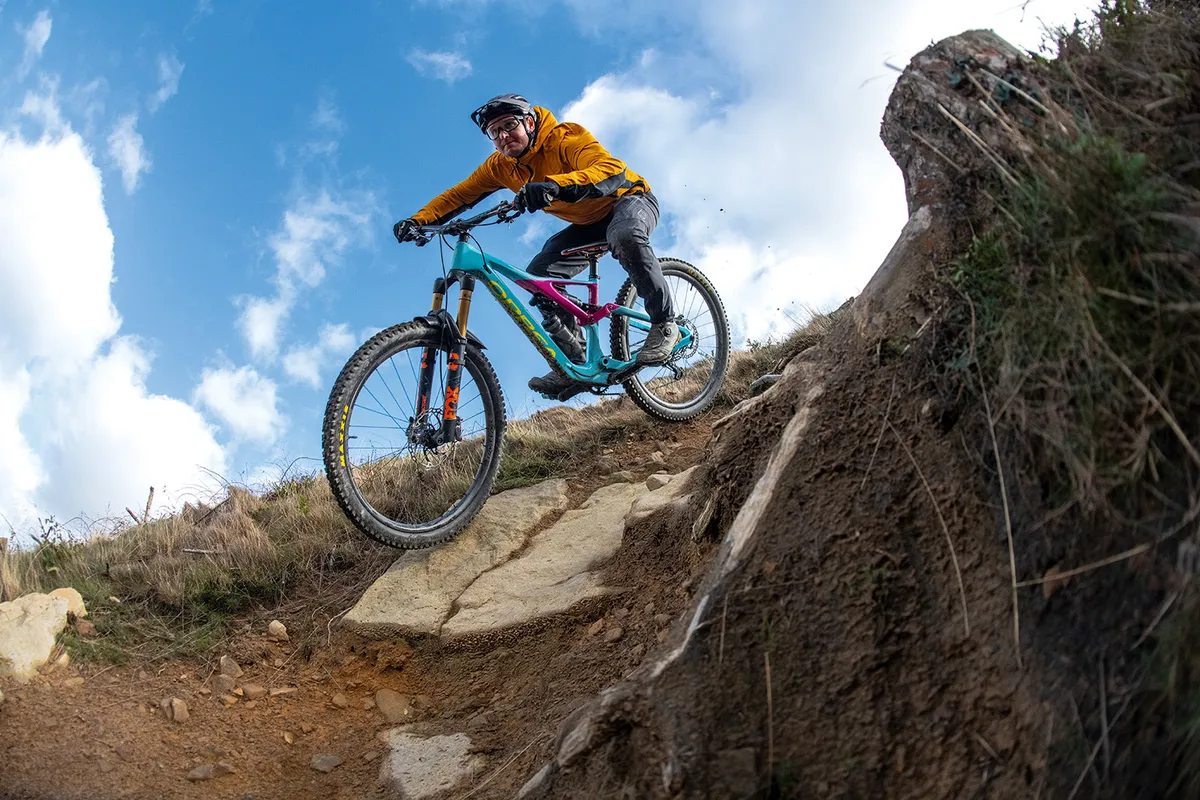
If you’re looking for an enduro bike with intuitive handling, then the Rallon is a strong choice. I found it easy to take it to my limits, requiring no changes in riding style or technique.
It keeps you engaged on all types of trails, but doesn’t make you feel nervous on any.
undefinedundefinedundefinedundefinedundefinedundefinedundefinedundefinedundefinedundefinedundefinedundefinedundefinedundefinedundefinedundefinedundefinedundefinedundefinedundefinedundefinedundefinedundefined